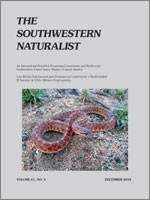Increasingly, endangered vertebrate species are being maintained in captive breeding programs as a method of ensuring their survival. Despite these increasing numbers of captive breeding colonies, there have been few studies designed to examine the long-term success of these programs at maintaining genetic diversity. To elucidate the effectiveness of a captive breeding colony of the endangered species Sauromalus varius (the San Esteban Chuckwalla) at maintaining genetic variation over time, we employed seven polymorphic microsatellite loci. F-statistics and analysis of molecular variance strongly suggest that the colony is exhibiting genetic signs of inbreeding. Genetic variation within the colony has decreased by an average of 12.2% within the colony between the 2 y sampled with an average loss of 30.5% of genetic variation within offspring. This study provides an important test of the effectiveness of captive breeding colonies at maintaining genetic variation within a vertebrate group over time.
How to translate text using browser tools
1 December 2016
Captive breeding of the endangered San Esteban Chuckwalla, Sauromalus varius: Effects of a decade of captive breeding on maintaining genetic diversity
L. Rex McAliley,
Ray E. Willis,
Craig Ivanyi,
Llewellyn D. Densmore
ACCESS THE FULL ARTICLE

The Southwestern Naturalist
Vol. 61 • No. 4
December 2016
Vol. 61 • No. 4
December 2016




